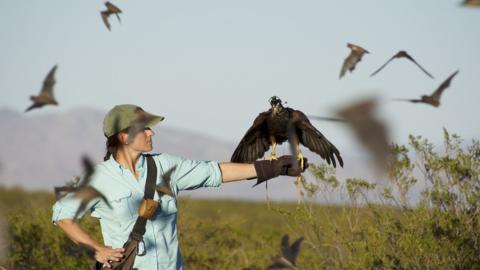Key Findings
New research shows that hawks that hunt swarming bats steer toward a fixed point in the swarm – rather than targeting individual bats – and attack, hoping for a successful capture. This behavior was observed of Swainson’s Hawks (Buteo swainsoni) and other raptors hunting a colony of approximately 700,000 to 900,000 Mexican free-tailed bats (Tadarida brasiliensis).
About the Co-Author
Laura Kloepper, Assistant Professor, Biological Sciences
Contact information: Laura.Kloepper@unh.edu, UNH Ecological Acoustics and Behavior Lab website
This research first published in Nature Communications.
Researchers: C. Brighton, L. Kloepper, C. Harding, L. Larkman, K. McGowan, L. Zusi, and G. Taylor
It is generally thought that being in a large group — such as a swarm of bats, flock of birds or school of fish — provides protection from predators due in part to the ‘predator confusion effect’: the idea that large numbers of potential targets will confuse predators, making it more difficult for them to focus on and capture a specific individual. If predators get confused, their success rate in capturing prey should decrease as the number of available prey increases. However, empirical evidence for the confusion effect has been mixed. New findings from a study co-authored by UNH researcher Laura Kloepper and recently published in Nature Communications aid our understanding of how predators select and track a target among thousands of potential prey.
Kloepper, who is a visiting assistant professor in the department of biological sciences, along with Caroline Brighton from the University of Oxford, the study’s lead author, and other colleagues used an array of cameras to reconstruct the 3D flight trajectories of the raptors and bats. While the research sheds light on why bats form dense aggregations and have remarkably coordinated movement when they emerge from caves and whether the predation risk from hawks drives their grouping behavior, the researchers’ analyses revealed that the hawks had developed a solution to the challenge of capturing specific prey in a dense swarm: instead of targeting an individual bat, they would target a fixed point within the throng. A bat on a collision course would appear to the raptor to be on a constant bearing, singling it out for snatching.
“Across the animal kingdom, we find that animals are constantly evolving adaptations and counter-adaptations to get one step ahead of each other,” she says. “Bats likely evolved this dense grouping to try to confuse predators, but hawks have evolved a strategy to avoid this confusion: instead of trying to target individual bats, they instead target the center of the dense group, extend their talons, and hope that the odds are in their favor.”

This project has received funding from the European Research Council (ERC) under the European Union’s Horizon 2020 research and innovation programme (Grant Agreement No. 682501) to G.T., and from an Office of Naval Research Young Investigator Award N000141612478 to L.K. Co-authors include C. Brighton, L. Kloepper, C. Harding, L. Larkman, K. McGowan, L. Zusi and G. Taylor.

